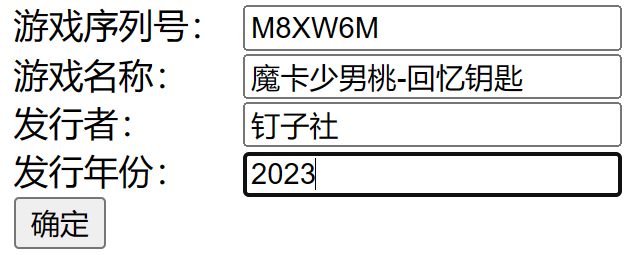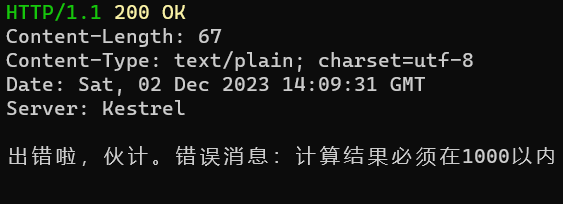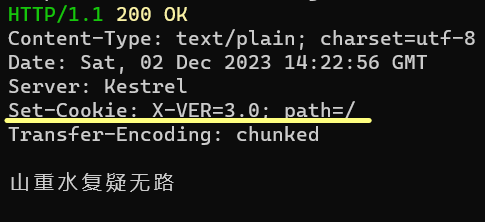前面老周给大伙伴们演示了过滤器的运行流程,大伙只需要知道下面知识点即可:
1、过滤器分为授权过滤、资源访问过滤、操作方法(Action)过滤、结果过滤、异常过滤、终结点过滤。上一次咱们没有说异常过滤和终结点过滤,不过老周后面会说的。对这些过滤器,你有印象就行了。
2、所有过滤器接口都有同步版本和异步版本。为了让伙伴不要学得太累,咱们暂时只说同步版本的。
3、过滤器的应用可以分为全局和局部。全局先运行,局部后运行。全局在应用程序初始化时配置,局部用特性类来配置。
4、实际应用中,我们不需要实现所有过滤器接口,需要啥就实现啥即可。比如,你想在 Action 调用后修改一些东西,那实现IActionFilter 接口就好了,其他不用管。
本篇咱们的重点在于“用”,光知道是啥是不行的,得拿来用才是硬道理。
我们先做第一个练习:阻止控制器的参数从查询字符串获取数据。
什么意思呢?咱们知道,MVC 在模型绑定时,会从 N 个 ValueProvider 中提取数据值,包括 QueryString、Forms、RouteData 等。其中,QueryString 就是URL的查询字符串。比如,咱们写一个这样的控制器:
public class GameController : ControllerBase { [HttpGet("game/play")] public string Play(Game g) { if(ModelState.IsValid == false) { return "你玩个寂寞"; } return $"你正在玩{g.Year}年出的《{g.GameName}》游戏"; } } public class Game { ////// 游戏序列号 /// public string? GameSerial { get; set; } /// /// 游戏名称 /// public string? GameName { get; set; } /// /// 谁发行的 /// public string? Publisher { get; set; } /// /// 哪一年发行的 /// 服务器托管网 public int Year { get; set; } }
这个通过 /game/play?gameserial=DDSBYCL-5K2FF&gamename=伏地魔三世&publisher=无德无能科技有限公司&year=2017 这样的URL就能传递数据给 g 参数。
这里我不做 HTML 页了,直接通过 MapGet 返回 HTML 内容。
app.MapGet("/", async (HttpContext context) => { string html = """试试看 label { min-width: 100px; display: inline-block; }"gserial" type="text" />"gname" type="text" />"text" id="pub" />"year" type="text"/>"res">
function reqTest() { let serial= document.getElementById("gserial").value; let name = document.getElementById("gname").value; let pub = document.getElementById("pub").value; let year = parseInt(document.getElementById("year").value, 10); let result = document.getElementById("res"); const url = `/game/play?gameSerial=${serial}&gamename=${name}&publisher=${pub}&year=${year}`; fetch(url, { method: "GET" }) .then(response => { response.text().then(txt => { result.innerHTML = txt; }); }); } """; var response = context.Response; response.Headers.ContentType = "text/html; charset=UTF-8"; await response.WriteAsync(html); });
设置响应的 Content-Type 头时一定要指定字符集是 UTF-8 编码,这样可以免去 99.999% 的乱码问题。向服务器发送请求是通过 fetch 函数实现的。
比如,咱们在页面上填写:

然后点一下“确定”按钮,提交成功后服务将响应:
你正在玩2022年出的《法外狂徒大冒险》游戏
模型绑定的数据是从查询字符串提取出来的。现在,咱们写一个过滤器,阻止 QueryStringValueProvider提供查询字符串数据。而QueryStringValueProvider 实例是由QueryStringValueProviderFactory 工厂类负责创建的。因此,需要写一个过滤器,在模型绑定之前删除QueryStringValueProviderFactory 对象,这样模型绑定时就不会读取 URL 中的查询字符串了。
于是,重点就落在选用哪种过滤器。关键点是:必须在模型绑定前做这项工作。所以,Action过滤器、结果过滤器就别指望了,而且肯定不是授权过滤器,那就剩下资源过滤器了。
咱们写一个自定义的资源过滤器——RemoveQueryStringProviderFilter,实现的接口当然是IResourceFilter 了。
using Microsoft.AspNetCore.Mvc.Filters; using Microsoft.AspNetCore.Mvc.ModelBinding; public class RemoveQueryStringProviderFilter : IResourceFilter { public void OnResourceExecuted(ResourceExecutedContext context) { // 空空如也 } public void OnResourceExecuting(ResourceExecutingContext context) { var qsValueProviders = context.ValueProviderFactories.OfType(); if (qsValueProviders != null && qsValueProviders.Any()) { context.ValueProviderFactories.RemoveType(); } } }
我们要做的事情是在模型绑定之前才有效,所以OnResourceExecuted 方法不用管,留白即可。在OnResourceExecuting 方法中,首先用ValueProviderFactories.OfType 方法找出现有的QueryStringValueProviderFactory 对象,若找到,用RemoveType 方法删除。
把这个过滤器应用于全局。
var builder = WebApplication.CreateBuilder(args); builder.Services.AddControllers(options => { options.Filters.Add(); }); var app = builder.Build();
现在,咱们再运行应用程序,输入游戏信息。

点击“确定”按钮后服务器托管网,发现服务未响应正确的内容。
你正在玩0年出的《》游戏
由于无法从查询字符串中提取到数据,所以返回默认属性值。为什么不是返回“你玩个寂寞”呢?因为模型绑定并没有出错,也未出现验证失败的值,只是未提供值而已,即ModelState.IsValid 的值依然是 true 的。
下面咱们看看异常过滤器怎么用。
异常过滤器最好定义为局部的,而非全局。使用局部过滤器的好处是针对性好,全局的话你用一个万能异常处理好像过于简单。当然了,如果你的项目可以这样做,就随便用。
这里我定义一个局部的异常过滤器,通过特性方式应用到操作方法上。
[AttributeUsage(AttributeTargets.Method, AllowMultiple = false)] public class CustExceptionFilterAttribute : Attribute, IExceptionFilter { public void OnException(ExceptionContext context) { // 看看有没有异常 if (context.Exception is null || context.ExceptionHandled) return; // 有异常哦,修改一下返回结果 ContentResult result = new(); result.Content = "出错啦,伙计。错误消息:" + context.Exception.Message; // 设置返回结果 context.Result = result; // 标记异常已处理 context.ExceptionHandled = true; } }
首先,context 参数是一种上下文对象,它在多上异常过滤器间共享实例(你可能实现了很多个异常过滤器)。context.Exception 属性引用的是异常类对象;注意一个有趣的属性ExceptionHandled,它是一个 bool 类型的值,表示“我这个异常过滤器是否已处理过了”。这个有啥用呢?由于上下文是共享的,当你的某个异常过滤器设置了ExceptionHandled 为 true,那么,其他异常过滤器也可以读这个属性。这样就可以实现:啊,原来有人处理过这个异常了,那我就不处理了。即 A 过滤器处理异常后设置为已处理,B 过滤器可以检查这个属性的值,如果没必要处理就跳过。
下面写一个控制器,并在方法成员上应用前面定义的异常过滤器。
public class AbcController : ControllerBase { [HttpGet("calc/add"), CustExceptionFilter] public int Add(int x, int y) { int r = x + y; if(r >= 1000) { throw new Exception("计算结果必须在1000以内"); } return r; } }
此处我设定抛出异常的条件是:x、y 相加结果大于或等于 1000。
咱们以 GET 方式调用,URL 为 /calc/add?x=599&y=699,这样会发生异常。服务器的响应为:

最后一个例子是结果过滤器。咱们要实现在响应消息中添加自定义 Cookie。
public class SetCookieResultFilter : IResultFilter { public void OnResultExecuted(ResultExecutedContext context) { // 不能在这里写 Cookie } public void OnResultExecuting(ResultExecutingContext context) { HttpResponse response = context.HttpContext.Response; // 设置Cookie response.Cookies.Append("X-VER", "3.0"); } }
这里要注意,咱们要写 Cookie 必须在OnResultExecuting 方法中处理,不能在OnResultExecuted 方法中写。因为当OnResultExecuted 方法执行时,响应消息头已经被锁定了,Cookie 是通过 set-cookie 标头实现的,此时无法修改 HTTP 头了,写 Cookie 会抛异常。所以只能在OnResultExecuting 方法中写。
定义一个控制器。
public class DemoController : ControllerBase { [HttpGet("abc/test")] public string Work() => "山重水复疑无路"; }
将自定义的结果过滤器添加为全局。
var builder = WebApplication.CreateBuilder(args); builder.Services.AddControllers(options => { options.Filters.Add(); }); var app = builder.Build();
好,试试看。

服务器托管,北京服务器托管,服务器租用 http://www.fwqtg.net
机房租用,北京机房租用,IDC机房托管, http://www.fwqtg.net
相关推荐: 记一次Redis Cluster Pipeline导致的死锁问题
作者:vivo 互联网服务器团队- Li Gang 本文介绍了一次排查Dubbo线程池耗尽问题的过程。通过查看Dubbo线程状态、分析Jedis连接池获取连接的源码、排查死锁条件等方面,最终确认是因为使用了cluster pipeline模式且没有设置超时时间…

